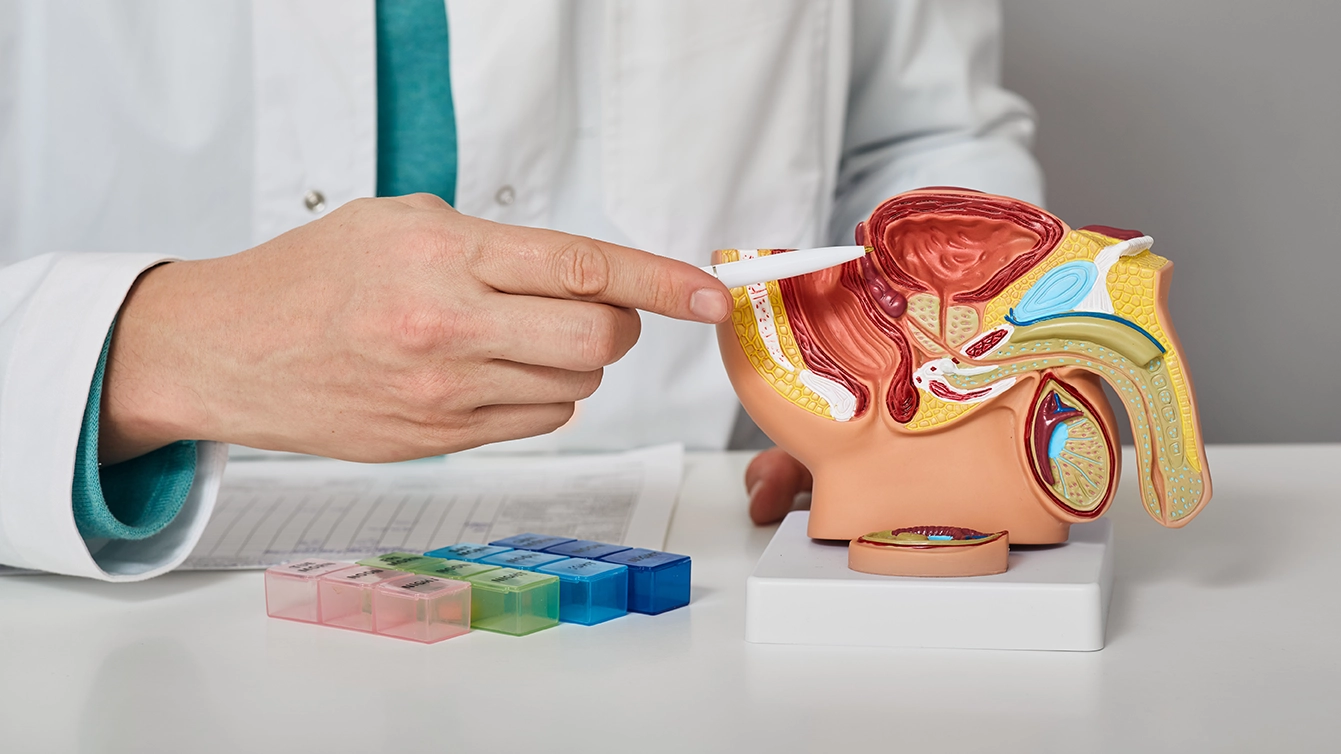AUA 2025: When Disaster Strikes: Managing Nightmare Cases in Urology
Case 1: Ureteral Avulsion During Stone Extraction
Presented by: Dr. Marshall Stoller & Dr. Davis Viprakasit
Dr. Marshall Stoller presented a case involving a 29-year-old male who suffered a proximal ureteral avulsion following ureteroscopic stone extraction performed abroad. Approximately 48 hours into recovery, the patient developed systemic and abdominal symptoms including fever, chills, abdominal pain, and distension. Upon evaluation at another hospital, he was diagnosed with ascites, and notably, white tubular material was observed protruding from the urethral meatus, which was cut with scissors, and then manually reinserted the remaining material into the bladder by another urologist. Subsequently, the patient returned to the original hospital where a nephrostomy tube was placed and cystoscopy was conducted for further evaluation.
Patient approached Dr. Stoller. Antegrade nephrostogram showed no contrast beyond proximal ureter. Cystoscopy revealed floating ureteral tissue and absence of the ipsilateral ureteral orifice. Imaging confirmed complete ureteral avulsion.
Dr. Davis Viprakasit talked about the case further.
- Ureteral avulsion, though rare, is one of the most feared endourology complications.
- It may be caused by forceful basketing, entrapped mucosa, or faulty instrumentation.
- Management begins with kidney decompression (e.g., nephrostomy) and careful assessment of renal function and injury extent.
- Surgical options include ileal ureter, renal autotransplant, or nephrectomy. In this case, an auto-transplant was performed with favourable long-term results.
Best Prevention Practices in Urological Stone Management:
Dr. Davis emphasized several key techniques and procedural best practices to prevent complications during ureteroscopic stone removal:
- Use of a Safety Wire: A safety wire is considered essential throughout the procedure. It provides a secure guide for re-accessing the ureter and minimizes the risk of losing access or causing trauma during re-insertion of instruments.
- Ureteral Access Sheath (UAS): When used appropriately, the UAS reduces repeated trauma to the ureter from multiple instrument passes. However, it should not be oversized or forced; careful sizing and placement are critical to avoid ischemia or ureteral injury.
- Laser Techniques – Dusting vs. Fragmentation:
- Dusting with low-energy, high-frequency laser settings allows fine pulverization of the stone without basket retrieval, reducing the risk of ureteral injury.
- Fragmentation followed by basketing may be necessary for larger stones, but Dr. Davis emphasized using lasers cautiously to avoid thermal damage.
- Basketing Techniques: Baskets should be used with minimal torque and only for fragments that are easily retrievable. Over-manipulation or pulling against resistance can cause ureteral avulsion or mucosal trauma. It's best to pre-dilate or stent if there's any resistance.
- Avoiding Over-Irrigation: Excessive irrigation pressure can lead to pyelovenous backflow and increase infection risk. Using a pressure-controlled system or gravity irrigation is preferred to maintain safety.
- Postoperative Stenting: In cases with prolonged manipulation, ureteral trauma, or residual edema, temporary stent placement helps reduce the risk of obstruction or stricture formation.
- Situational Awareness and Team Communication: Recognizing when resistance is encountered or when the anatomy is unclear is vital. Dr. Davis stressed the importance of stopping, reassessing imaging, and not forcing progress. Effective communication with anaesthesia and nursing staff ensures intraoperative safety.
Takeaway Message: “Don’t pull.” Avulsion is a never event. Calm, measured intraoperative response, team communication, and honesty with the patient are paramount.
Case 2: Intraoperative Rectal Injury in Robotic Prostatectomy:
Presented by Dr. Sanjay Patel & Dr. Jen-Jane Liu.
A 55-year-old male underwent a robotic-assisted radical prostatectomy for prostate cancer. During the dissection at the prostatic apex, a rectal defect was identified intra-operatively.
Immediate Recognition and Management:
- The injury was promptly recognized, a critical factor in minimizing postoperative complications.
- The rectal wall defect was visualized directly through the robotic field, allowing for controlled intervention.
- The surgical team performed a primary repair using a two-layer closure technique:
- An inner layer using absorbable sutures for the mucosa.
- An outer seromuscular layer to reinforce the closure and isolate it from the urinary tract.
Intraoperative Measures:
- An air leak test was performed by insufflating the rectum via a rigid proctoscope while the pelvis was irrigated, confirming watertight closure.
- Interposition of omentum or peritoneal flap was considered to further isolate the repair, depending on availability and exposure.
- A diverting colostomy was not performed in this case, as the injury was small, clean, and promptly repaired with no evidence of contamination or devitalized tissue.
Postoperative Care:
- The patient received broad-spectrum antibiotics and was placed on bowel rest initially.
- Careful monitoring for signs of infection, fistula, or leak was instituted.
- Follow-up imaging (e.g., contrast enema or CT) was planned to ensure healing prior to resumption of full enteral intake.
Discussion and Takeaways:
Drs. Patel and Liu emphasized that early recognition and immediate repair are the most critical determinants of good outcomes in rectal injuries. Delayed diagnosis significantly increases the risk of rectourethral fistula, sepsis, and prolonged hospitalization.
Contributing risk factors include:
- Prior radiation
- Inflammatory bowel disease
- Locally advanced tumours
- Difficult dissection planes
Surgeons should maintain a high index of suspicion in high-risk patients and use gentle dissection, particularly near the rectal wall.
Best Practices:
- Careful attention during dissection at the posterior apex.
- Use of intraoperative visualization tools to identify and assess any breach immediately.
- Ensuring team readiness to perform primary repair without delay.
- Avoidance of colostomy when appropriate based on size, location, and cleanliness of injury.
Managing Intraoperative Ureteral Injuries
Presented by: Dr. Niels Johnsen & Dr. Katie Anderson
Drs. Katie Anderson and Niels Johnson presented strategies for managing ureteral injuries, especially when reconstructive surgeons are called in post-complication. The session emphasized collaborative repair, respectful intraoperative communication, and decision-making under pressure.
Types of Urethral Disasters
- Retained ureteral catheter fragments (missed during colorectal surgery)
- Proximal ureteral laceration seen intraoperatively in a pancreatic resection
- Wrong ureter clipped during a nephroureterectomy
- Complete ureteral avulsion, identified via protrusion from the urethral meatus
These cases are often chaotic, emotionally charged, and require rapid, composed evaluation.
Approach Upon Being Called Intraoperatively:
- Initial Steps:
- Show empathy and professionalism
- Assess patient stability: determine if damage control is needed
- Understand surgical context (e.g., prior surgeries, radiation history)
- Review imaging and patient anatomy, including for duplicated systems
- Technical Prep:
- Check for lithotomy position (accessibility for cystoscopy)
- Identify reconstructive options: immediate repair vs. staged return
Case Example: Ureteral Leak Post-Robotic Prostatectomy
- A 49-year-old patient developed abdominal distension and urine in JP drain postoperatively.
- CT urogram confirmed distal ureteral leak.
- Surgical Repair Steps:
- Proximal ureter dissection in an untouched plane
- Minimized ureteral handling using a vessel loop for traction
- Ureteral spatulation and bladder mobilization
- Psoas hitch to bridge ureteral length & anterior cystotomy for easier visualization
- Refluxing ureteral reimplant using a running anastomosis
- Stent placement, using techniques such as assistant port wire guidance or angiocath
Reconstructive Options Based on Injury Extent:
|
Option |
Use when |
Consideration |
|
Psoas hitch |
Most distal injuries |
Safe, easy, minimal morbidity |
|
Boari flap |
Mid-ureteral injury |
Risk of LUTS; patient counselling preferred |
|
Ileal ureter |
Long-segment defects |
Requires prior planning and patient consent |
|
Renal auto-transplant |
Rarely needed |
For complex, proximal injuries |
|
Tag & delay |
When repair isn’t feasible |
Mark ureter for future repair; avoid further trauma |
Postoperative and Delayed Repair Considerations:
- Timing depends on surgical approach (laparoscopic vs. open) and contamination control
- Laparoscopic: 8–10 weeks
- Open: ~12 weeks
- Imaging and proper drainage critical
- Robotic re-operation encouraged unless hostile abdomen
Technical Pearls:
- Change your view (e.g., new retractor angle) to find missed injuries.
- Always check for multiple injuries or duplicated systems.
- Refluxing anastomoses are standard in adults; address bladder dysfunction before blaming reflux.
- Know when to delay: strategic timing may yield better long-term outcomes.
Take-Home Messages:
- Iatrogenic ureteral injuries are rare but serious
- Individualized patient assessment is key
- Maintain a broad toolkit of reconstructive strategies
- Prioritize tension-free, mucosa-to-mucosa anastomosis
- Call for help when needed—collaboration improves outcomes
American Urological Association 2025, April 26-29, Las Vegas, NV




